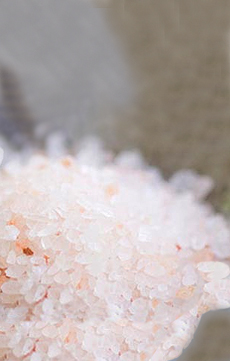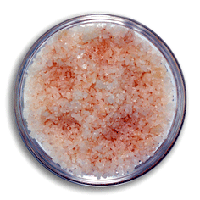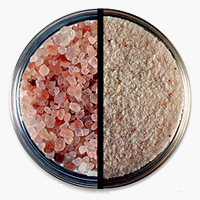

This pink salt is ground from slabs of primordial ocean deposits that have been protected in the remote, pristine Himalayan Mountains for 250 million years. The former became salt mines. Photo courtesy HimalaSalt.com.
September 2005
Last Updated September 2010
|
 |
Culinary Salt Glossary
Page 6: Pink Salt, Popcorn Salt & Other Terms Beginning With Letters P ~ R
This is Page 6 of a 7-page glossary. Some of the terms below include pickling salt, pink Himalayan salt and rock salt. After you’ve read up on sea salt, take a look at our other food glossaries—an easy way to get up to speed on more than 50 different food categories.
Click a letter to go to the appropriate glossary page.
a b c d e f g h i j k l m n o p q r s t u v w x y z
This glossary is protected by copyright and cannot be
reproduced in whole or in part.
PALUDIER
Grey salt and Fleur de Sel are collected by hand with wooden rakes by artisan paludiers (salt harvesters, salt rakers or salt farmers) who sweep the top of the evaporating sea water. This is the same 1500-year-old method developed by their Celtic ancestors which earns the grey salt its alternate name of Celtic sea salt. New paludiers study for one year to learn the slow and precise movements and patient methods of the ancient craft. Most are drawn to the profession by a love of nature, working outdoors, and the romance of tradition. The average age of a paludier is now under 40, thanks both to a renewed interest in the craft and the explosion in popularity of sea salt. There are around 200 traditional paludiers in France today, working a total of 2,000 hectares of salt-marshes and producing an annual harvest of 10,000 tons of quality sea salt. See also saunier.
PERUVIAN PINK SEA SALT
This salt is harvested from an ancient ocean now underground, which feeds a spring located 10,000 feet high in the Andes. The salt has a mineral quality. Sprinkle a few grains on sliced ripe tomatoes, hard-boiled eggs, and potatoes.
PICKLING SALT
A fine-grained salt used for pickled meat dishes and for canning. Pickling salt is similar to table salt but lacks the iodine and additives that turn pickles dark and the pickling liquid cloudy. Since it is a very fine and concentrated salt, it can be used like sea salt in cooking. Pickling salt is available in supermarkets, and is also referred to as canning salt. |
|

Photo courtesy of SaltWorks.us. |
PINK HIMALAYAN SALT
Pink Himalayan salt is mined from deep inside the Himalayan Mountains in Tibet, where the was deposited when the sea covered the area more than 250 million years ago. Often the salt is brought down from the mountains on the backs of yaks. It is available in a variety of grinds (e.g., coarse at left and fine at right, in the photo at the left), as well as in small rocks with a grater (which makes a very dramatic presentation). The unrefined and unpolluted pink translucent crystals have a subtle, crunchy texture.
|
|

Photo courtesy of SaltWorks.us.
|
POLDER
Polders are shallow clay pools that are created to harvest fine quality Atlantic sea salt. Paludiers, sea salt farmers, are still today hand harvesting the mineral rich salt that collects in the shallow clay pools. Currently, only 3,000 polders on Isle de Noirmoutier are maintained, e.g. but new paludiers are training and restoring more as time goes by.
POPCORN SALT
A very fine-grained salt that sticks better to popcorn and other foods such as French fries. Popcorn salt is available as a white salt or in a variety of flavors, some with butter flavoring included. If you are using unflavored popcorn salt, you can grind regular table salt in your spice grinder rather than pay a premium for “popcorn salt.”
ROCK SALT or ICE CREAM SALT or HALITE
The crudest and least refined salt, non-food-grade, containing mud and debris. It is used for melting snow or lowering the freezing point of ice for ice cream makers.
Go To Page 7: Salt Terms Beginning With Letter S ~ V
Return To The Article Index Above

|






